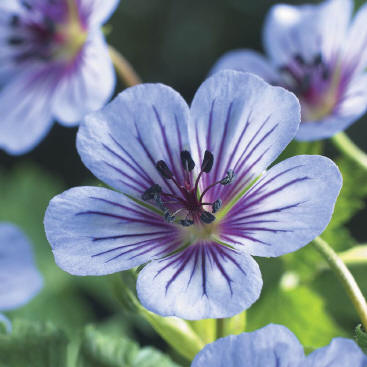
(10/3) This summer has been a difficult growing year, at least for me. The spring was great. Enough rain and cool temperatures allowed my garden to flourish, at least until July came bumbling in. Then things began to get ugly. At first, it was just another dry spell, nothing that the gardens couldn’t continue to look good through. Then the rain
continued to skirt around us and leaves on plants became brittle. Perennials developed brown margins on the leaves. Grass crunched as you walked across it. Stems of plants began to die back. All a gardener could do was hand water and hope for the best. The best a person could hope for by late August was to keep stuff alive, and who cared if it looked good anymore, as long
as the roots were healthy.
However dry things were, a gardener quickly realized the benefit of the plants that tolerated dry soils. The perennials that often take back seats in a garden suddenly became the star. My star was the hardy geranium.
Hardy geraniums, unlike the annual geraniums (pelargonium), live for many years. They like semi-sun and well drained soils. The summer dryness has certainly stressed the plants in my garden, but it is one of the perennials that suffered quite elegantly through the "no rain" season. Under a large zelcova, my geranium sanguineum still looks pretty
good. The leaves are still hanging on, unlike my sad, sad anemomes. The plants are beginning to turn a nice fall color, and little browning has occurred.
The geranium is typically used, not as a star, but as a grouping of plants that accent some other star. Acting as a groundcover, most of the hardy geraniums look great as understory plants, accenting focal points in the garden, highlighting taller perennials or tropical plants. They can be used successfully along beds as edging, or in the
foreground, with something spectacular behind it or within it.
Ranging in colors from dark lavender/purple to white, the geranium is a tough and quite tolerant plant. They bloom from mid-May through June, depending on the species and range from 6" tall to 2’. Bonus: the deer seem to walk away from them, not bothering to even manage a taste.
Geranium sanguinium is one of the shortest species. Dark green foliage through the summer, the leaves turn a pretty red in the fall. Dark pink flowers cover the plant in the spring and sporadically bloom throughout the summer months.
Geranium × cantabrigiense 'Biokovo' is also a low growing geranium, reaching about 8" tall. This pretty little plant has pale pink flowers with darker pink streaks. I also grow this one in my garden. It, too, has proven that not all plants wilt without water! As most geraniums, it has created a nice groundcover and is now developing a pretty red
fall color, complementing the orange fall color from its neighboring Lo-gro fragrant sumac.
A taller geranium, one that reaches about 18", is Geranium ‘Rozanne’. Receiving the recognition as "Perennial Plant of the Year" in 2008, Rozanne has become very popular in the industry. As with most geraniums, it is heat tolerant and has a nice red fall color. This particular selection is more mounded in habit and has lavender flowers in May-June,
and will re-bloom in late summer if cut back. It can stand alone in a garden, not relying on other geraniums to carry on its mission to accent something else. ‘Rozanne’ can become the spring and fall highlight.
Geranium ‘Johnson’s Blue’ has been one of the most popular geraniums over the years. Well known for its large clear blue flower, it has become a staple in many gardens. It tolerates full sun, but does best in part sun. It is recommended that after the spring bloom, this plant is cut back to maintain a more compact habit. In my garden this plant
gets floppy and open reaching about 12"-18". It blooms in June and would definitely benefit from a good hair cut in July.
One of my favorite geraniums is Geranium phaeum ‘Samobor’. This plant has burgundy flowers and green foliage with dark markings. I have it growing in a shade garden with Heuchera ‘Caramel’ and the color combination of leaves is striking. The plants are relatively compact, about 12" tall with the flowers stretching above the foliage another 8",
giving it a very airy feel when it’s blooming. It’s very easy to grow and is very happy in its moist but well drained locations.
Our native geranium, Geranium maculatum, can be found in the northeast and Midwest. They can reach 2’ – 2 ˝ ‘ tall, and can typically be seen growing in a semi-shady to shady location in moist soils. They are long lived, as are most geraniums. The flowers are lavender and clusters are held loosely on top of wiry stems. We have this growing at the
Agricultural and Natural Resource center since 2002 and it is still going strong. Although it can be a little floppy in a garden, it adds nice spring color in May, with texture from the lobed leaves through the summer and a nice red fall color. Although not easily found in garden centers, this plant is worth looking for to add to your woodland garden.
A selection of our native geranium is Geranium maculatum ‘Espresso’. Selected because if its dark almost brown leaves, this plant has pink flowers that fade to white in late May. Just like the straight species, this selection prefers semi-shade to shade and moist soils. It adds nice texture with its strongly lobed leaves and brown leaf color to a
shade garden, mixing great with hostas and ferns. This particular selection is one I’d like to add to my garden.
Geraniums are easy to grow, deer resistant, with very little disease and insect issues. I can’t think of a more versatile plant group. When the right plant is chosen, a beautiful display is the reward. These plants are very easily found at local nurseries and garden centers. Every shade of pink, white and blue can be found. Use them as ground
covers or to mix in to your perennial border. Be diligent with sun and shade varieties for optimum growth and success. Geraniums have quickly become one of my top picks, and after you grow them, I’m certain they will be yours too.
Read other articles on plants and gardens
Read other articles by Mary Ann Ryan